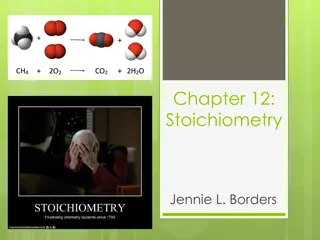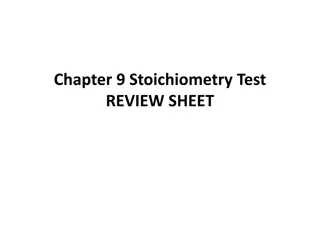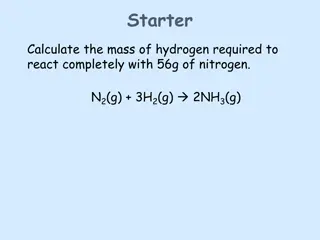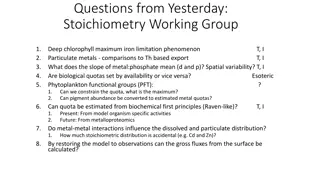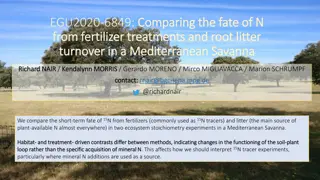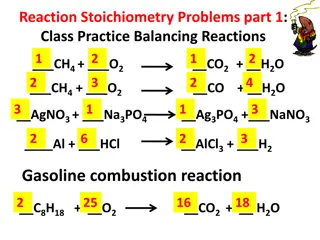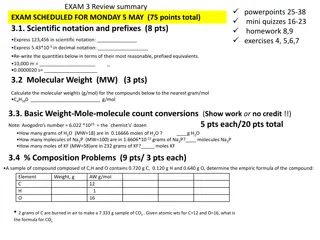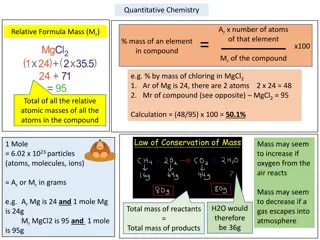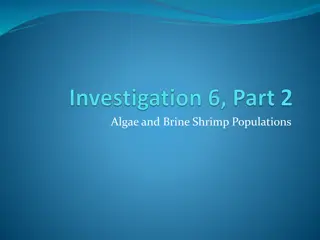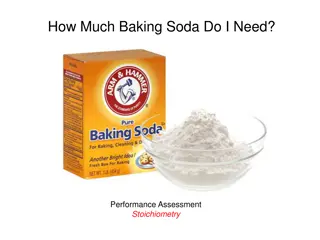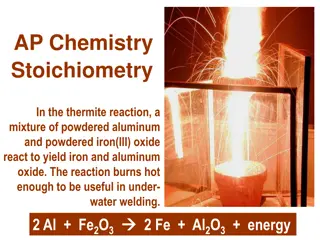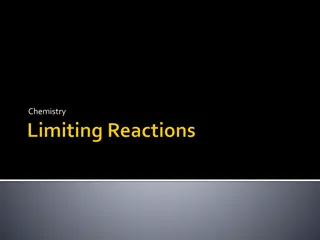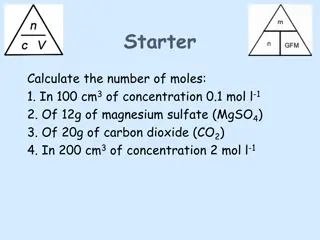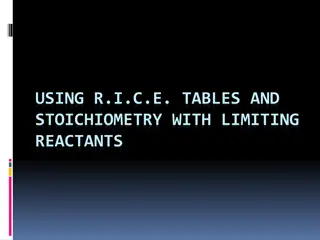Understanding Limiting Reactants in Stoichiometry
In chemical reactions, the limiting reactant is crucial in determining the amount of product that can be formed. Learn how to identify the limiting reactant through mass-to-mass conversions using examples and practice problems. This process ensures optimal product yield based on the available reactants.
Download Presentation

Please find below an Image/Link to download the presentation.
The content on the website is provided AS IS for your information and personal use only. It may not be sold, licensed, or shared on other websites without obtaining consent from the author. Download presentation by click this link. If you encounter any issues during the download, it is possible that the publisher has removed the file from their server.
E N D
Presentation Transcript
Turn in Stoichiometry Practice, Part One handout. Pick up Notes. Get out periodic table and a calculator.
Rarely are reactants in a chemical reaction present in the EXACT balanced equation. Usually one or more are in excess is limited The substance that is completely consumed in a reaction is the limiting reactant reaction cannot continue without more of it. Excess left over EXACT ratios specified by the excess while one limited. consumed limiting reactant. The Excess reactants are the reactants that are left over, in excess.
VIDEO DEMO
Example: Recipe for Chocolate Chip Cookies yields 4 dozen cookies 2.25C flour 1t salt 1t baking soda 3 oz. chocolate chips 1 C butter 1 C sugar 2 eggs 2 t vanilla 0.5 C brown sugar
If you have the amounts listed below, what is the limiting reactant? 10 C flour 4t salt 4t baking soda 10 oz. chocolate chips 4 C butter 4 C sugar 4 C brown sugar 12 eggs 8 t vanilla How many cookies could you make with these amounts?
Treat these problems as mass to mass problems and then compare the answers to determine the limiting reactant. The limiting reactant will be the one that converted to the LESSER LESSER amount. Example: How many grams of CO2are formed if 10.0 grams of C are burned in 20.0 g of O2. C + O2 CO2 1 mole C + 1 mole O2 1 mole CO2
Do the math just like you did with the mass to mass problems. Only this time you are doing two two. One for 10.0 g of carbon and one for 20.0 g of O2.
10.0 g C 1 mole C 1 mole CO2 12.01 g C 1 mole C 1 mole CO2 44.01 g CO2 = __________g CO2 20.0 g O21 mole O21 mole CO2 32.00g O21 mole O2 44.01g CO2 1 mole CO2 = __________gCO2
10.0 g C forms 36.6 g CO2 AND 20.0 g O2forms 27.5 g CO2 Carbon forms more product and is left over. So, oxygen oxygen is the limiting reactant and 27.5 CO2is produced 27.5 g
Nickel reacts with hydrochloric acid to produce nickel (II) chloride and hydrogen gas. If 5.00g nickel and 2.50g hydrochloric acid react, determine the limiting reactant and the mass of nickel (II) chloride produced.
WYK: WYK: EQN: EQN: SOLVE: SOLVE:
Ni + 2HCl NiCl2+ H2 5.00g Ni 1 mol Ni 1 mol NiCl2129.59g NiCl2 58.69g Ni 1 mole Ni 1 mol NiCl2 = 11.04021128 = 11.0g NiCl2 Limiting Reactant 2.50g HCl 1 mol HCl 1 mol NiCl2129.59g NiCl2 36.46g HCl 2 mol HCl 1 mol NiCl2 = 4.442882611 = 4.44g NiCl2 Amount made
Sometimes we want to know how much of the excess was left over in grams. There are two steps to calculating how much is left over or IN EXCESS .
1. Convert the grams of NiCl2 for the limiting reagent (HCl) back to grams of Ni. This will show how much Ni was actually actually needed. 4.44gNiCl2 129.59g NiCl2 1 mol NiCl2 1 mol Ni 1 mol NiCl2 1 mol Ni 58.69g Ni = _____________gNi 2. Subtract this mass of Ni needed from the original amount: 5.00g Ni 2.01 2.01g Ni = 2.99 2.99 g Ni
Now try it for the sample problem given previously. Find the amount of excess carbon. 1. Convert grams of CO2 made from oxygen back to gams of carbon. 2. Subtract this mass of carbon from the original amount of carbon.
Limiting Reactant Practice is due Monday. There will be a quiz Monday over Stoichiometry problems (no limiting reactant). We will also do a lab on Monday.





